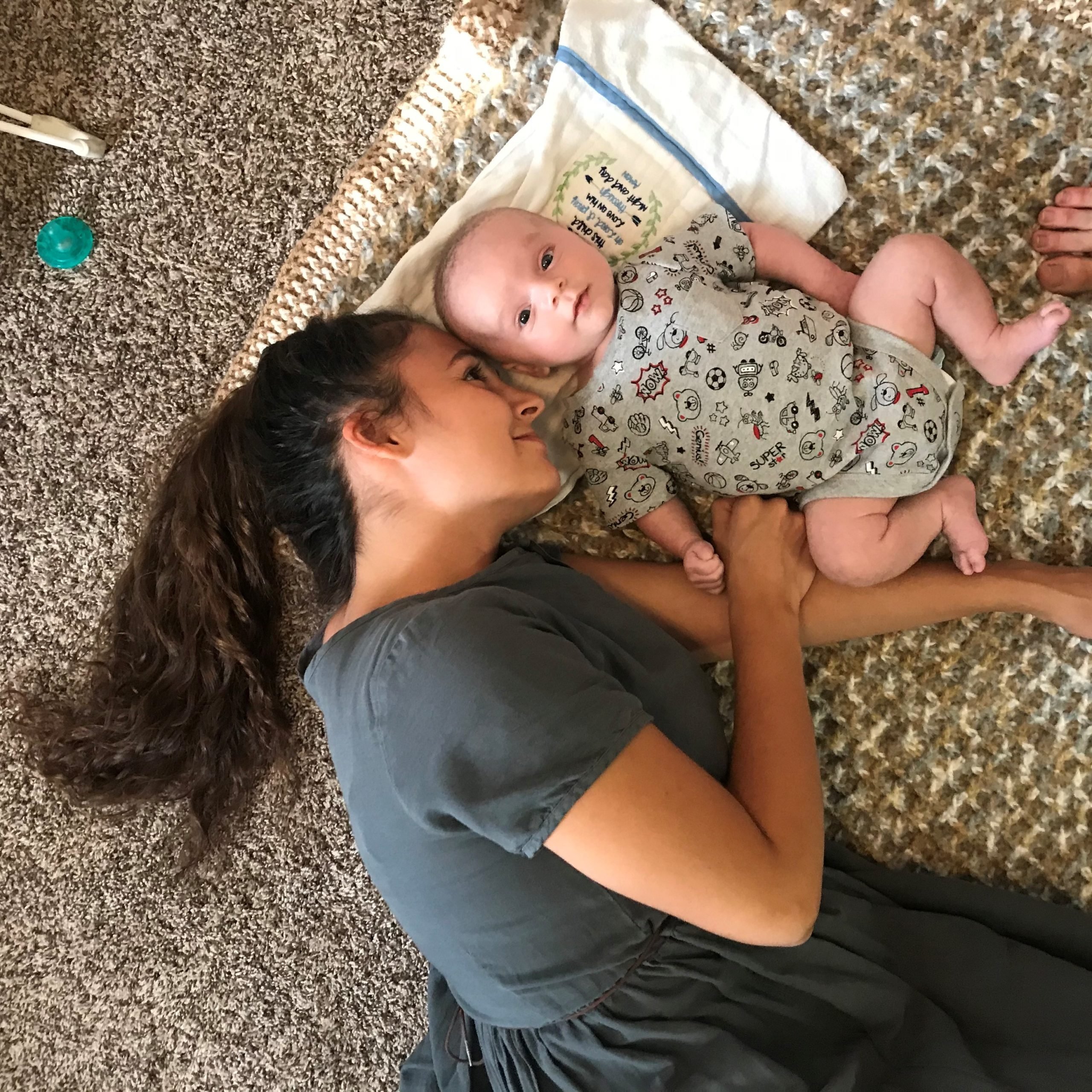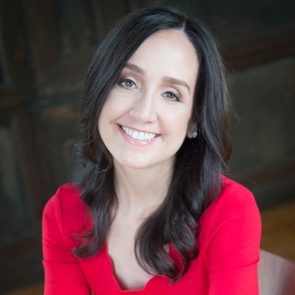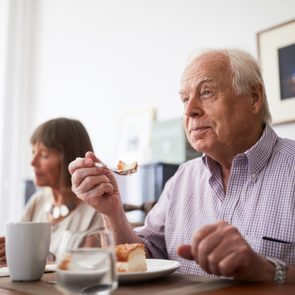I’m 24 and I Had a Massive Stroke
Updated: Mar. 16, 2022
A 24-year-old stroke survivor reveals how grateful she is about the rare condition that followed her pregnancy, and how it changed her life for the better.

In the United States, someone experiences a stroke every 40 seconds, and these strokes kill 140,000 Americans a year. Cerebral venous sinus thrombosis (CVST) is a rare type of stroke that affects just one in five million people. They can be deadlier than general strokes, and some women can face an increased risk in the third trimester of pregnancy: before, during, and right after giving birth. A CVST happens when a blood clot forms in the brain’s venous sinuses, preventing blood from draining out of the brain and causing a hemorrhage inside the brain tissues.
“Strokes in women in their 20s and 30s are a lot more common than you think,” says Nicole Weinberg, MD, cardiologist at the Women’s Heart Center at the Pacific Heart Institute in California, and previous co-director of the annual Women’s Heart Symposium. “Pregnancy is a risk factor because higher levels of female hormones, particularly estrogen, can hurt the integrity of blood vessels. They affect how the vessels stretch and contract which can make them more vulnerable to blood clots.”
Sarah-Grace Richardson, a 24-year-old mother of two, had a CVST shortly after her pregnancy this year. Prior to her stroke, Richardson was a runner and was very health conscious. However, she unknowingly had two factors that increased her risk for CVST: pregnancy and ulcerative colitis. An optimist, Richardson has turned her situation into a positive and says she’s grateful for the stroke because it has helped her change her life. This is her story.
I had a complicated pregnancy
April 18, 2020, was one of the happiest days of my life when my son, Everett, was born happy and healthy. It would quickly be followed by one of the hardest days of my life when, just two days later, I had a massive stroke.
From the very beginning of this pregnancy, things were very different than my experience with my first son, Bear. Bear’s pregnancy was easy and uncomplicated; delivery and recovery were smooth. However, at the beginning of Everett’s pregnancy, I was diagnosed with ulcerative colitis, an inflammatory bowel disease that causes inflammation, pain, and sores in the digestive tract. It flared up throughout the pregnancy and so I spent most of those nine months very sick. Yet just when I thought I couldn’t feel worse, a few days before my due date I started to experience major headaches. I told my husband they felt like lightning was striking the top of my head.
Stroke symptoms we all ignored
I was beginning to suspect something was wrong with me but the possibility of a stroke never entered my mind. I was young and healthy! Who has a stroke at 24? [Here’s a story about a young stroke survivor.] Plus, I had to focus on my baby. The headaches never stopped but they became my second concern while I went into labor and delivered Everett. Immediately after delivery, I couldn’t stop vomiting. In hindsight, the vomiting and headaches were signs of an impending stroke, but neither I nor my doctors recognized it. [Make sure you know these stroke symptoms in women that get ignored.]
They sent me home with my newborn and I tried to settle into new motherhood, but nothing was going right. In addition to the headaches and nausea, I was unable to get my baby to breastfeed, nor was I able to sleep. It just felt like I was losing control of my body and it wouldn’t move or act the way I wanted it to. It was a weird-enough feeling that we called my ob-gyn, who chalked up my symptoms to lack of sleep and urged me to give the baby to my husband and take a long nap. I took his advice.
Blood clots and a brain bleed
When I woke up, I couldn’t move the right side of my body. My husband rushed me to the emergency room where scans found multiple blood clots and a serious brain bleed. Most strokes are caused by clots in the arteries and happen very quickly, but because of the location of the clots in the veins of the brain, CVST [cerebral venous sinus thrombosis] strokes happen more gradually. My situation was so dire that my local hospital made the decision to transfer me to IU Health Methodist Hospital in Indianapolis. Through the throbbing headache, I remember my family surrounding me and hugging me and praying for me. Then they loaded me into the ambulance and that would be the last time I would get to see them for weeks. Due to Covid-19 restrictions, they were unable to come with me nor would they be allowed in the hospital during what would turn out to be a very long stay. [Here’s what you need to know about Covid-19 and strokes.]
By the time I arrived at Methodist, I was fully paralyzed, other than a tiny bit of movement in my left foot. It was a terrifying realization that I couldn’t even itch my nose if I needed to. Yet, I was still fully aware of what was happening around me. It was a flurry of tests and machines and doctors talking in hushed tones around me.
Battling between life and death
I don’t remember much of what happened next other than I was put into the intensive care unit [ICU] and they worked around the clock to save my life. Because I had both a brain bleed and blood clots, it was tricky to help one without making the other worse. I managed to ask one of the doctors, “Am I going to die?” and she simply replied, “I don’t know.” I would later learn that my husband, father-in-law, and pastor spent that night in their car outside my hospital because the doctors had told them that they would let them in to say good-bye to me if it looked like I would die.
Thankfully, the next day after they’d gotten the bleeding under control and reduced the swelling in my brain, they were finally able to say, with hesitancy, “We believe she’s going to survive this.” [Here are things you can do right now to reduce your stroke risk.]
A beacon of hope at the hospital
I was in the ICU, still totally paralyzed, my ulcerative colitis worse than ever, and I was missing my husband and babies terribly—but from that moment on, I was full of hope. The doctors told my family to prepare for me to need to be in a nursing home for the rest of my life but I knew I was going to recover. I had already survived a stroke that the doctors agreed was usually unsurvivable, and God wasn’t going to let the miracles stop there.
After 10 days in the ICU, I was deemed stable enough to move to a different ward in the hospital. That day I felt my right hand “wake up” and I could move my neck a little bit. My speech was slower but I never lost the ability to talk. It was beautiful progress. After five days there, they said I’d progressed enough to move to a rehabilitation hospital nearby. [Here are the signs of silent strokes.]

Regaining strength with stroke rehab
When I first arrived at the rehab hospital on May 5, my medical team made some goals for me to be able to use a wheelchair independently before being able to go home. But as my husband and the occupational therapist talked about wheelchair ramps and shower bars, I had bigger goals in mind. The first day I started physical therapy, I was able to shuffle my left foot a little while the physical therapist moved my other limbs for me. By day three, thanks to dedicated therapists and plenty of prayer, I was walking on my own. My medical team said that they’d never seen anyone improve that quickly. [Check out physical therapist secrets.]
From there I improved quickly. I spent the next three weeks in rehab and I had to relearn everything. It was like being born a baby all over again and having to learn all the basics, like how to grasp things or turn around. It was tough! Honestly, it was a very humbling experience and gave me a lot more sympathy and respect for what my two little ones were going through. All of those little things I’d taken for granted for so long were now a daily struggle. I still remember the first time I was able to lift a piece of bacon to my mouth and eat it—it was such a victory! And showering myself? Absolute joy!
Singing loud and clear
I’ve always loved to sing—by myself, with my husband, to our kids, at church—and during this process, it became my saving grace. Especially at the beginning, when I couldn’t do much but sing! The doctors encouraged this as not only did it keep my spirits up but it was improving and healing the damaged parts of my brain. I remember one day I was singing outside when two elderly men came out. I stopped but they asked me to continue as it made them happy to hear me. I realized then that I had never lost my voice for a reason and this was one way I could still help others too. There were more impromptu mini-concerts. [These are the incredible health benefits of music.]
At the end of my stay, I decided to make my secret chocolate chip cookie recipe for my medical team and all of the staff who had helped me so much. It was mind-blowing for all of us. At the end of April, I’d been completely paralyzed. By the beginning of July, I was measuring out ingredients, scooping dough, managing the oven, and carrying plates of warm cookies.
Moving forward with my family and my health
On May 22 I was released to go home—not to a nursing home and not even in a wheelchair: I was going back to my sweet family. At first, I couldn’t be left alone and was very limited to what I could do. My husband tapped the Family and Medical Leave Act so he could care for me and the kids. But just like I’d so quickly regained movement and strength, now I worked on regaining all of those little homemaking skills. I did outpatient rehab therapy through July.
As of now, at the beginning of October, I can do everything I could do before, except for driving. My right leg is still a little weak so the doctors don’t feel like it’s safe for me to resume that yet, but I know I’ll get there. I’m on medication for my ulcerative colitis and blood thinners to keep dissolving the blood clots (apparently they take at least six months to resolve!) but other than that I don’t need any ongoing medical care.
The other day, I put both my boys in the stroller and pushed them three miles to the park where I was able to play with them. As I chased them in the sunshine, it hit me all over again what a miracle this is and continues to be!

My life after having a stroke
This experience could have hardened me, made me angry, and ask “why me?” but it didn’t. I know this was part of God’s plan for my life and have seen the ways He used this experience to impact lives all over the world. I have chosen to focus on every little positive thing that happens.
I’m actually less stressed now than I was before because the stroke has helped me put things into perspective and I no longer take any of the little things for granted. My house isn’t clean? No matter, I got to play with my boys and they’re worth way more than a stack of dishes. I make time for what I truly love; I read and sing and sew and paint more. And I never get tired of looking into my infant’s face and remembering the incredible story of how we both got to where we are now. I had a stroke giving birth. And I wouldn’t change a thing.
—As told to Charlotte Hilton Andersen














